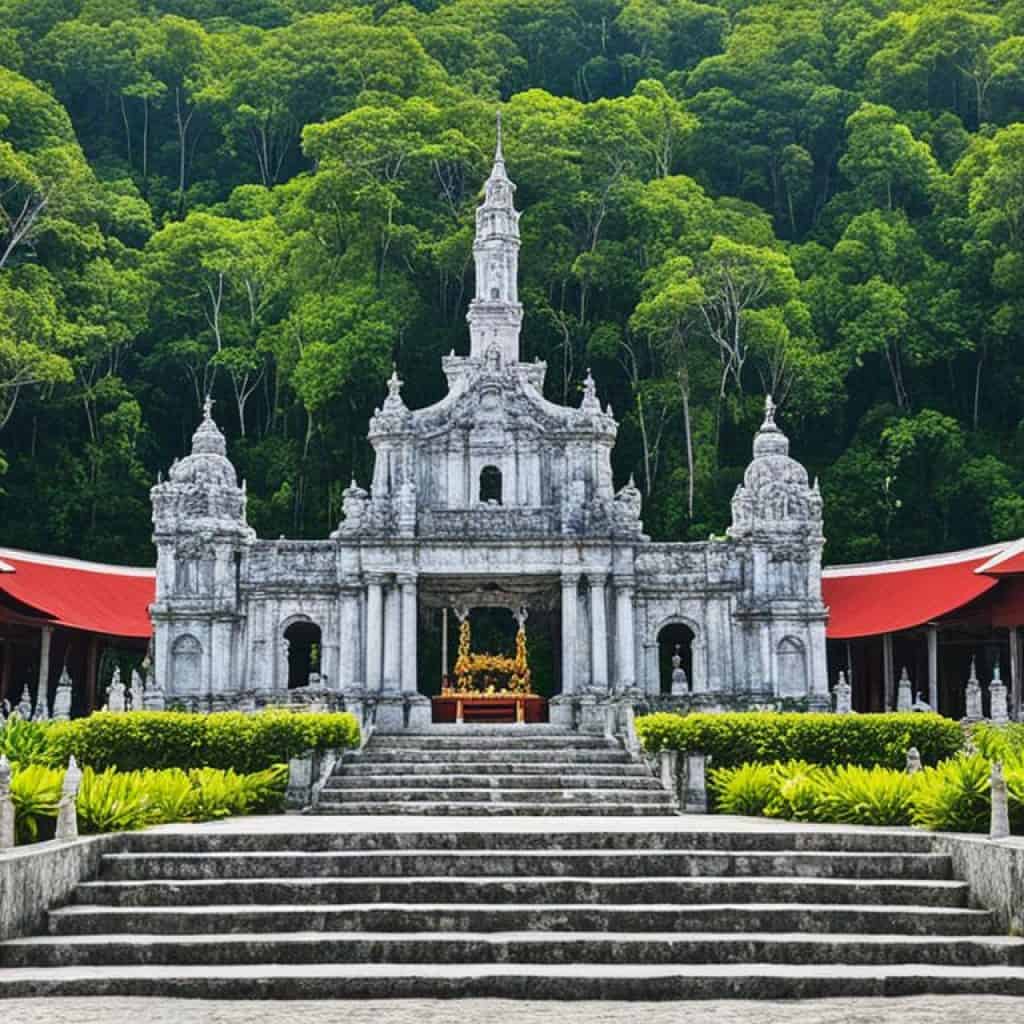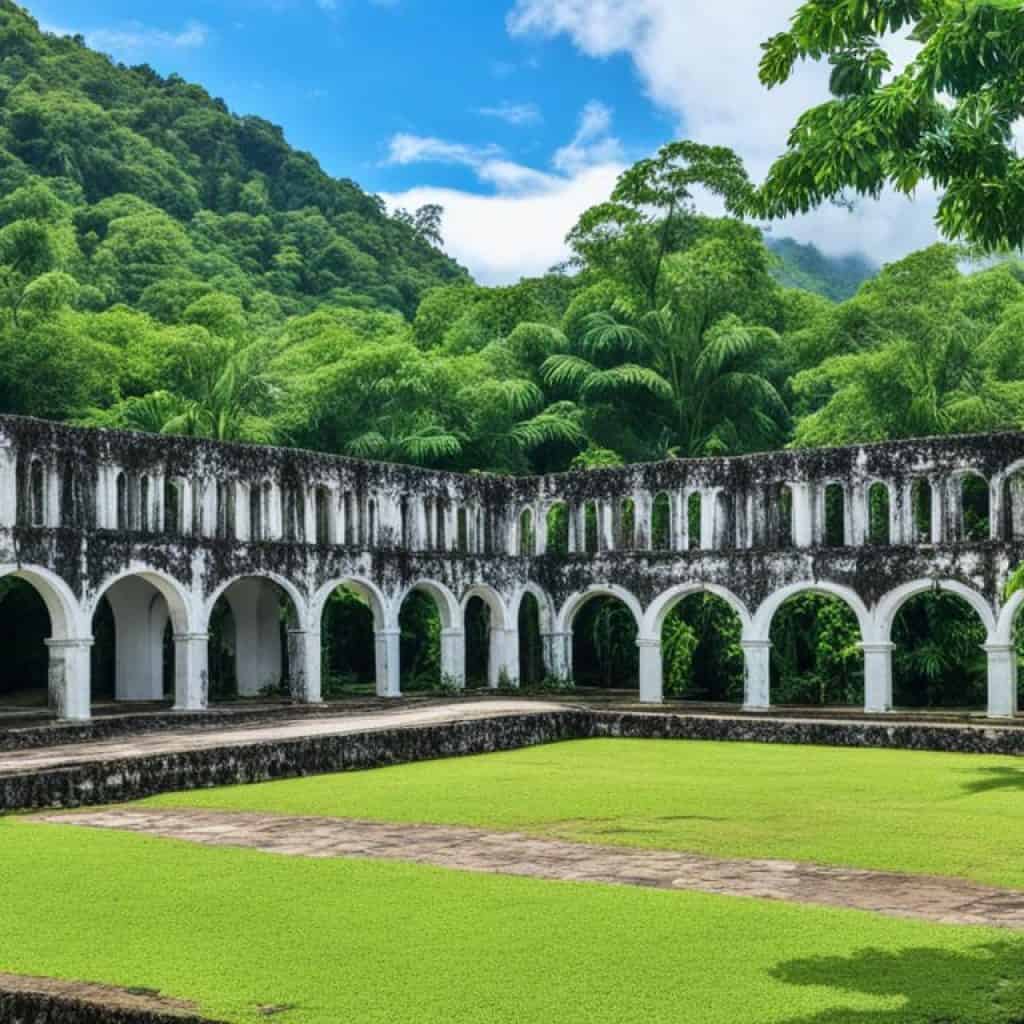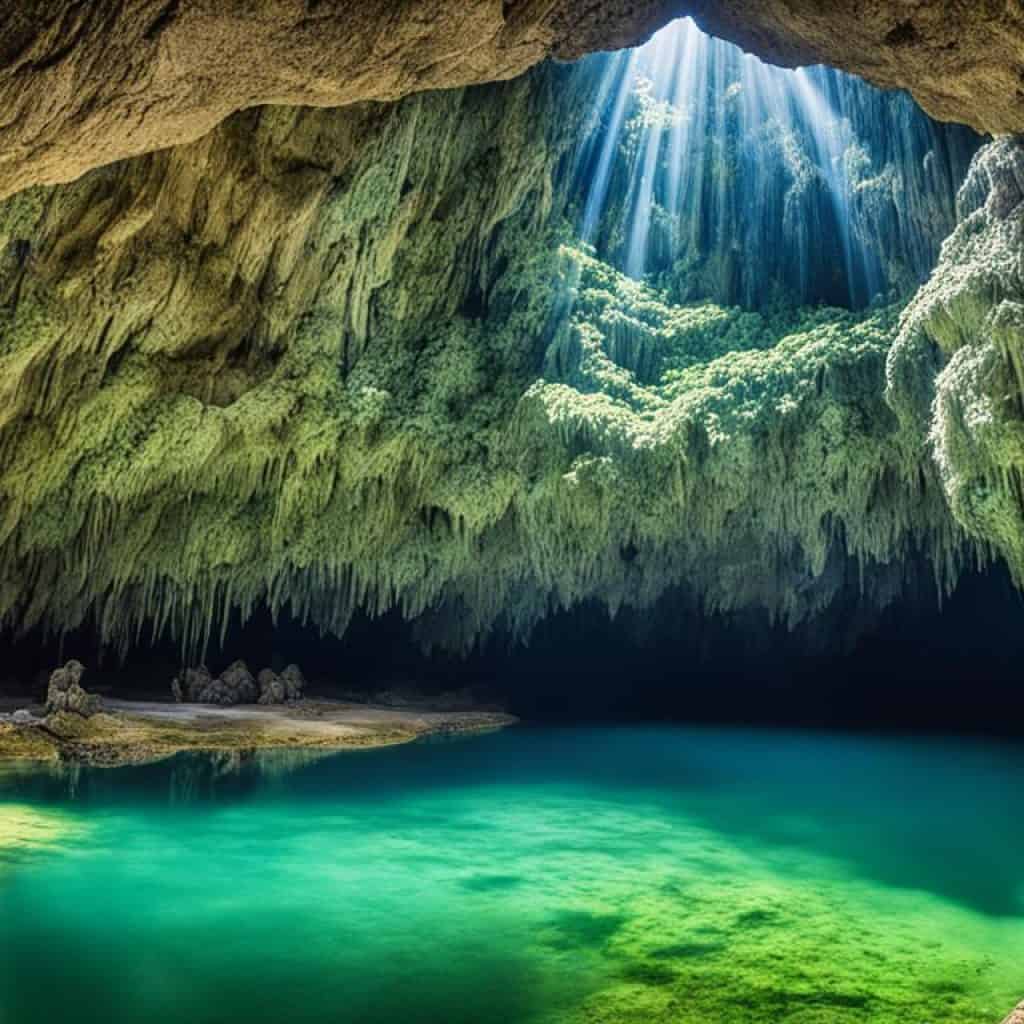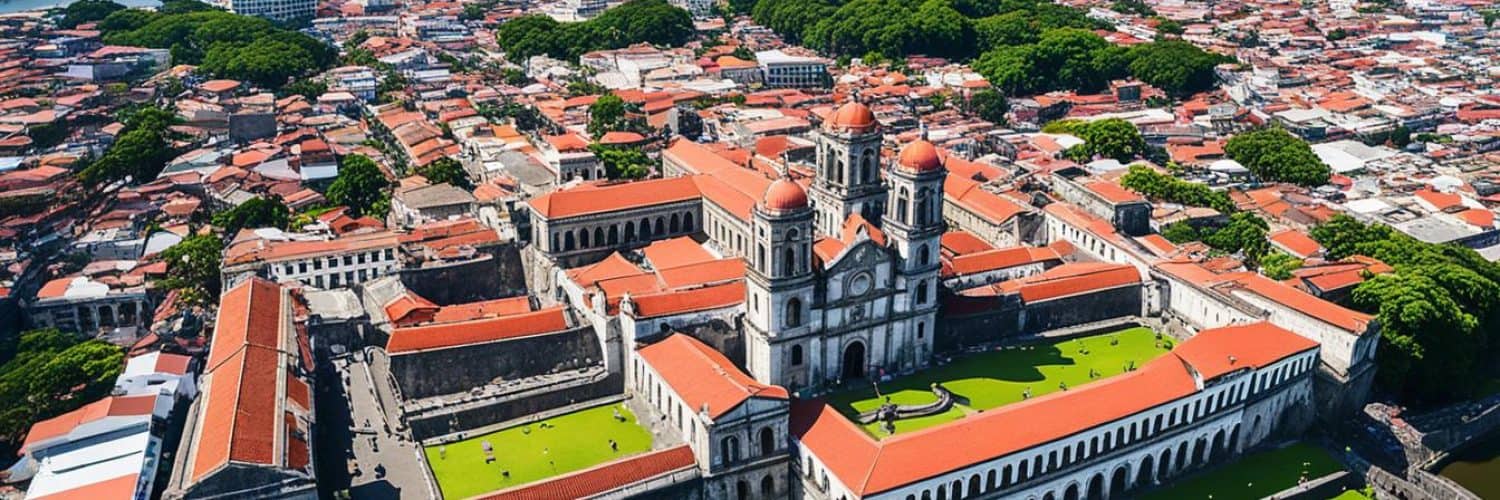The Philippines is known for its breathtaking landscapes, vibrant culture, and warm hospitality. But did you know that it is also home to some of the most fascinating historical landmarks in the world? From ancient mosques to iconic monuments, these sites offer a glimpse into the rich and diverse history of this Southeast Asian nation. Join us as we embark on a journey to uncover the hidden stories and remarkable heritage behind the famous landmarks in the Philippines.
Sheik Karim al Makdum Mosque, Tawi-Tawi
The Sheik Karim al Makdum Mosque in Tawi-Tawi is a remarkable historical site that holds great significance in the Philippines. As the oldest mosque in the country, dating back to 1380, it stands as a testament to the enduring presence of Islamic culture in the Philippines.
This National Cultural Treasure showcases the intricate beauty of Islamic architecture. The mosque’s design features remarkable craftsmanship and attention to detail, leaving visitors in awe of its grandeur. Notably, the pillars of the mosque are made of Ipil hardwood, which are among the oldest Islamic artifacts in the Philippines.
A visit to the Sheik Karim al Makdum Mosque offers more than just architectural marvels. It provides a unique opportunity to immerse oneself in the colorful and rich Islamic culture that thrives in the southern parts of the Philippines. Exploring the mosque allows visitors to gain a deeper understanding of the traditions, customs, and values prevalent in the Islamic community.
The Sheik Karim al Makdum Mosque stands as a testament to the country’s diverse cultural heritage, offering a profound glimpse into the Islamic influence that has shaped the Philippines’ history. It is a must-visit destination for history enthusiasts, cultural explorers, and anyone seeking to appreciate the beauty and significance of the nation’s oldest mosque.
Leyte Landing Memorial Park
The Leyte Landing Memorial Park in Palo, Leyte is a significant historical site that commemorates General Douglas MacArthur’s return to the Philippines during World War II. This momentous event, symbolized by the powerful phrase “I shall return,” marked a turning point in the Filipinos’ struggle for freedom from Japanese forces.
Located at the very spot where MacArthur landed on October 20, 1944, the Leyte Landing Memorial Park stands as a testament to the bravery and tenacity of the Filipino people. Bronze statues of MacArthur and other key figures of the era, including President Sergio Osmena and General Carlos P. Romulo, were erected in the park to honor their vital roles in the liberation of the country.
“I have returned. The hour of your redemption is here.”
A visit to the Leyte Landing Memorial Park offers a chance to pay homage to the heroism and sacrifices of both the Filipino and American forces during World War II. It serves as a poignant reminder of the resilience and determination that ultimately led to the restoration of freedom and sovereignty in the Philippines.
Key Features of Leyte Landing Memorial Park:
- Bronze statues of General Douglas MacArthur, President Sergio Osmena, and General Carlos P. Romulo
- Historic marker indicating the exact spot of MacArthur’s landing
- Beautifully landscaped gardens and promenades
- Memorial Wall with the names of Filipino and American soldiers
- Panoramic views of Leyte Gulf and Samar Island
- Visitors Center showcasing artifacts, photographs, and documents from the era
Sandugo Shrine, Bohol
The Sandugo Shrine in Bohol is a testament to the historic Spanish-Filipino friendship and the tribal traditions that have shaped the rich cultural heritage of the Philippines. This shrine commemorates the blood compact, a sacred ritual performed by Spanish explorer Miguel Lopez de Legazpi and Bohol chieftain Datu Sikatuna.

This blood compact, known as “Sandugo” in the native language, was a pivotal moment in history as it marked the first treaty of friendship between Spaniards and Filipinos. It symbolizes the union and trust between the two cultures and remains an important symbol in Filipino history.
The Sandugo Shrine, adorned with a magnificent bronze sculpture by National Artist Napoleon Abueva, stands as a reminder of the enduring bond between Spain and the Philippines. It is a popular destination for tourists who seek to explore the rich history and natural wonders of Bohol.
“The Sandugo Shrine in Bohol is a powerful testament to the Spanish-Filipino friendship and the cultural traditions that have shaped our nation. It represents the unity, trust, and respect that underpin our vibrant heritage. A visit to this shrine is a journey into our shared past, where we can reflect on the bonds that have endured through centuries.”
– Local Historian
Experience the Sandugo Shrine:
When you visit the Sandugo Shrine in Bohol, you will have the opportunity to:
- Witness the intricate bronze sculpture by National Artist Napoleon Abueva, which portrays the blood compact between Miguel Lopez de Legazpi and Datu Sikatuna.
- Explore the surroundings of the shrine, which boast breathtaking natural beauty and stunning views of the ocean.
- Learn about the history and cultural significance of the blood compact through informative exhibits and guided tours.
- Immerse yourself in the vibrant tribal traditions of Bohol through performances, music, and dance.
| Opening Hours | Entrance Fee | Location |
|---|---|---|
| Open daily from 9:00 AM to 5:00 PM | Free | Bohol, Philippines |
Jose Rizal Shrine, Dapitan
The Jose Rizal Shrine in Dapitan, Zamboanga del Norte, holds significant historical value as it served as the four-year exile residence of national hero Jose P. Rizal. Accused of plotting the revolution against Spanish rule, Rizal spent his time reflecting and writing poetry within the walls of this shrine. A visit to the Jose Rizal Shrine offers a profound insight into the life and legacy of Jose Rizal, shedding light on his contributions to the Philippine Revolution.
The shrine is home to various landmarks that hold historical importance, such as the “Mi Retiro Rock.” It was here that Rizal found solace, immersing himself in contemplation and creative expression. His time in Dapitan was a period of immense personal growth and intellectual exploration, where he shared his knowledge and pursued various endeavors for the betterment of society.
Baler Church
The Baler Church, also known as San Luis Obispo de Tolosa Parish, is a significant historical landmark in Baler, known for its surf-perfect waves. Built in 1611, this church was the site of the Siege of Baler, a battle that took place during the Philippine Revolution. The church’s structure, made from stones plastered by lime and honey, still stands as a testament to the town’s rich history and its role in the fight for Philippine independence.
During the Siege of Baler, a group of Spanish soldiers took refuge in the church for almost a year, enduring constant attacks and scarce resources before finally surrendering. Today, the Baler Church stands as a poignant reminder of the bravery and resilience of both sides involved in the conflict. It serves as a symbol of the Philippines’ struggle for independence and the countless sacrifices made during this tumultuous period in history.
The Baler Church’s architectural design showcases the influence of Spanish colonialism in the Philippines. Its thick stone walls, bell tower, and intricate details reflect the blend of local and European aesthetics. The church continues to be a place of worship and an important cultural heritage site, attracting visitors from all over the world.
“The Baler Church stands as a poignant reminder of the bravery and resilience of both sides involved in the conflict.” – Local Historian
Plaza Cuartel, Puerto Princesa
Located in Puerto Princesa, Palawan, Plaza Cuartel holds a significant place in the pages of Filipino history. During World War II, this site served as a garrison for both Filipino and American soldiers. Today, Plaza Cuartel stands as a powerful memorial, reminding us of the sacrifices made during the war and the unwavering resilience of the Filipino people.
Plaza Cuartel witnessed the horrors of the Japanese occupation, where prisoners of war were held captive. Tragically, many of these prisoners were burned alive in an underground tunnel by Japanese forces. The site now serves as a somber reminder of their bravery and the indomitable spirit of the Filipino soldiers.
“Plaza Cuartel stands as a testament to the courage and sacrifice of our heroes. It serves as a poignant reminder of the dark days of war and the strength of the Filipino people.”
A visit to Plaza Cuartel is a profound experience, allowing visitors to pay homage to those who gave their lives for the cause of freedom. As you walk through this historic landmark, take a moment to reflect on the sacrifices made during World War II and to honor the memory of those who fought for their country.
Plaza Cuartel is not just a place of remembrance but also a symbol of hope and resilience. It stands as a testament to the Filipino spirit and serves as a reminder of the importance of cherishing and preserving our history for future generations.
The Significance of Plaza Cuartel
| Location | Historical Period | Noteable Features |
|---|---|---|
| Puerto Princesa, Palawan | World War II |
|

Emilio Aguinaldo Shrine, Kawit, Cavite
The Emilio Aguinaldo Shrine in Kawit, Cavite, holds great historical significance as it was the house where the declaration of Philippine Independence from Spanish rule took place in 1898. This national shrine stands as a testament to the courage and resilience of the Filipino people in their fight for freedom.
The Emilio Aguinaldo Shrine features a museum that houses a collection of artifacts from the historic event, providing visitors with a deeper understanding of the Philippine Independence movement. The museum showcases important documents, personal effects, and memorabilia of Emilio Aguinaldo, the first President of the Philippines, offering a glimpse into his life and the challenges faced during that pivotal time in history.
One intriguing aspect of the Emilio Aguinaldo Shrine is the presence of secret passageways and compartments. These hidden corridors once served as hiding places for important documents and weapons, adding an air of mystery to the already rich historical narrative.
“The Emilio Aguinaldo Shrine stands as a symbol of Philippine Independence, reminding us of the sacrifices made by our ancestors. It serves as a beacon of hope and inspiration for future generations to continue the fight for freedom and to cherish the hard-earned independence we enjoy today.”
Exploring the Emilio Aguinaldo Shrine is a truly immersive experience that allows visitors to step back in time and gain a deeper appreciation for the events and personalities that shaped Philippine history. It is a must-visit destination for anyone seeking to understand and honor the struggles and triumphs of the Filipino people.
Quick Facts: Emilio Aguinaldo Shrine
| Location | Kawit, Cavite |
|---|---|
| Significance | Site of the declaration of Philippine Independence |
| Museum | Displays artifacts and memorabilia from the Philippine Independence movement |
| Features | Secret passageways and compartments |
Mt. Samat, Bataan
Located in the town of Pilar, Bataan, the Mount Samat National Shrine, also known as the Shrine of Valor, stands as a solemn tribute to the Filipino and American soldiers who valiantly fought and made the ultimate sacrifice against Japanese forces during World War II.
The centerpiece of the shrine is the Memorial Cross, a magnificent structure that soars 95 meters above the ground. Crafted with granolithic marble, this towering symbol of courage and resilience serves as a constant reminder of the bravery and sacrifice of those who fought for freedom.
Visiting Mt. Samat offers a powerful and humbling experience, allowing visitors to pay their respects and gain a deeper understanding of the tumultuous events of World War II. The tranquil surroundings and panoramic views make it an ideal place for quiet reflection and solemn remembrance.
Tabon Cave, Palawan
Tabon Cave in Palawan is often referred to as the “Cradle of Civilization” in the Philippines. This renowned cave gained immense acclaim when an astonishing discovery was made within its ancient walls. A 20,000-year-old skull cap, believed to belong to the Tabon Man, was unearthed, shedding light on the early inhabitants of the region and providing invaluable insights into our shared human history.
The cave complex in Tabon also yielded a wealth of archaeological artifacts, further cementing its significance in understanding the prehistoric era. Among these treasures are stone tools, animal bones, and even human fossils dating back an astounding 47,000 years. These artifacts unveil the intricate tapestry of human existence and offer a captivating glimpse into the lives of our ancestors.
A visit to Tabon Cave is a journey back in time, allowing visitors to immerse themselves in the ancient history of the Philippines. As you explore the cavernous chambers and marvel at the artifacts, a deep appreciation for the remarkable journey of human civilization is bound to take hold. It is an experience that sparks curiosity, encourages exploration, and fosters a greater understanding of our collective past.

| Archaeological Artifacts | Approximate Age |
|---|---|
| 20,000-year-old skull cap | 20,000 years |
| Stone tools | 47,000 years |
| Animal bones | 47,000 years |
| Human fossils | 47,000 years |
Delving into the ancient history of the Philippines at Tabon Cave is an awe-inspiring experience. The archaeological artifacts and remarkable discoveries found within these hallowed grounds serve as a testament to the ingenuity and resilience of our early ancestors. It is a destination that honors the profound significance of these archaeological treasures and invites us all to connect with our shared human heritage.
Basilica del Santo Niño, Cebu
The Basilica del Santo Niño in Cebu City is a must-visit historical and religious landmark in the Philippines. It holds the esteemed title of being the oldest Roman Catholic church in the country, with its origins dating back to the 16th century. This iconic basilica is deeply intertwined with the rich history and culture of Cebu, making it a significant pilgrimage site for both locals and tourists.
The Basilica del Santo Niño is known for housing the statue of the Child Jesus, which was gifted by Ferdinand Magellan to Queen Juana of Cebu in 1521. This sacred statue, also known as the Santo Niño de Cebu, holds great reverence among the Filipino Catholic community and is a symbol of devotion and faith.
One of the most vibrant and celebrated events held at the Basilica del Santo Niño is the Sinulog Festival. This grand religious and cultural festival takes place every third Sunday of January and honors the Santo Niño. The Sinulog Festival attracts thousands of devotees and revelers who come together in joyous processions, street dances, and elaborate performances. It is a spectacle of colorful costumes, rhythmic music, and a true showcase of Cebuano traditions and customs.
“The Basilica del Santo Niño stands as a testament to the enduring faith of the Filipino people and serves as a reminder of the vibrant religious and cultural heritage of Cebu.”
Stepping inside the Basilica, visitors are greeted by its magnificent architecture and ornate interior. The church boasts a combination of Spanish Baroque and neoclassical styles, with intricate details adorning its façade. The vibrant hues and elaborate decorations create a visually stunning and reverent atmosphere.
For those seeking a deeper connection to their faith or a cultural immersion in Cebu, a visit to the Basilica del Santo Niño offers a profound experience. The church not only represents the spiritual heart of Cebu but also holds a special place in the history and identity of the Filipino people.
Rizal Park, Manila
Rizal Park, located in Manila, is a historic urban park and one of the largest in Asia. It is named after the national hero, Jose Rizal, whose monument stands prominently within the park.
Rizal Park has witnessed significant historical events, such as the declaration of Philippine independence and the EDSA Revolution. It also houses the National Museum Complex, which showcases various art and cultural exhibits.
The Rizal Monument at the heart of the park is a popular landmark that pays homage to the Philippine national hero, Jose Rizal. The monument portrays Rizal standing tall, holding a book and a pen, symbolizing his role as a writer and intellectual who fought for the country’s independence.
Rizal Park serves as a venue for various cultural and recreational activities, attracting both locals and tourists. Visitors can take leisurely walks, enjoy picnic areas, or ride a horse-drawn carriage called a kalesa to explore the park’s expansive grounds.
Historical Significance
“Rizal Park is a testament to the Filipino people’s enduring spirit and love for freedom. It has witnessed key moments in Philippine history and continues to be a cherished symbol of the nation’s struggle for independence.”
Today, Rizal Park stands as a reminder of the sacrifices made by national heroes like Jose Rizal, and it plays a vital role in preserving Filipino history and culture. It serves as a gathering place for celebrations, protests, and various events, making it a bustling hub of activity.
Whether exploring the park’s lush gardens, admiring the historical statues and monuments, or simply taking in the vibrant ambiance, a visit to Rizal Park offers an opportunity to immerse oneself in Philippine history and appreciate the enduring legacy of the nation’s heroes.
| Key Features | Location | Visitor Information |
|---|---|---|
|
Ermita, Manila |
|
Conclusion
The historical landmarks in the Philippines offer a captivating journey through the nation’s rich tapestry of history and culture. These iconic landmarks are must-visit attractions that allow visitors to immerse themselves in the fascinating stories and events that have shaped Filipino history.
Exploring the ancient mosques in Tawi-Tawi or wandering through the cobblestone streets of Intramuros in Manila is like stepping back in time. These landmarks serve as powerful reminders of the tragic and triumphant moments in the country’s past, offering a deeper understanding of the Filipino identity.
Whether you are a history enthusiast or simply seeking to appreciate the cultural heritage of the Philippines, these historical landmarks are a treasure trove of knowledge and beauty. Delve into the intriguing world of Filipino history and discover the remarkable stories that have influenced the nation. Plan your visit today and embark on a journey that will truly enrich your understanding of this vibrant and diverse country.
Don’t miss the opportunity to explore these must-visit attractions, where you can witness firsthand the remarkable fusion of Filipino history and culture. Each landmark holds a unique significance and offers a glimpse into the remarkable resilience and spirit of the Filipino people.


















Add comment